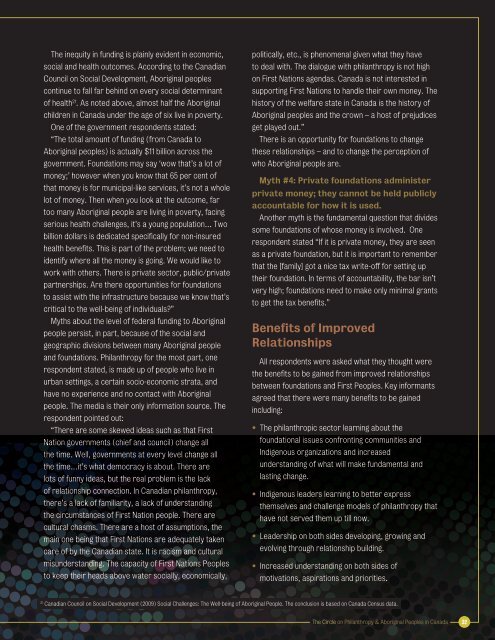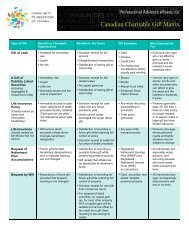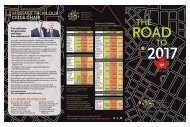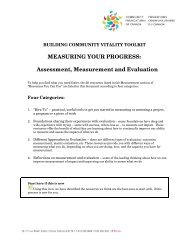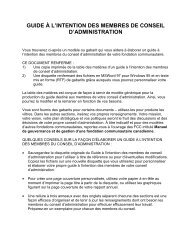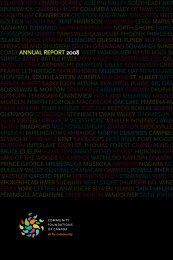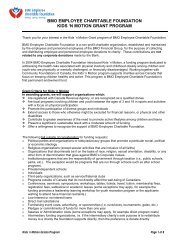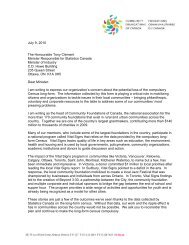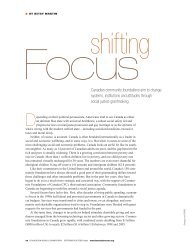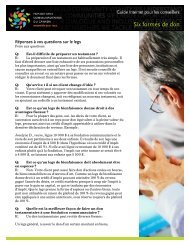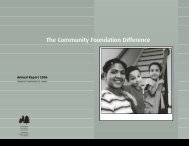Aboriginal Philanthropy in Canada: A Foundation for Understanding
Aboriginal Philanthropy in Canada: A Foundation for Understanding
Aboriginal Philanthropy in Canada: A Foundation for Understanding
Create successful ePaper yourself
Turn your PDF publications into a flip-book with our unique Google optimized e-Paper software.
The <strong>in</strong>equity <strong>in</strong> fund<strong>in</strong>g is pla<strong>in</strong>ly evident <strong>in</strong> economic,<br />
social and health outcomes. Accord<strong>in</strong>g to the Canadian<br />
Council on Social Development, <strong>Aborig<strong>in</strong>al</strong> peoples<br />
cont<strong>in</strong>ue to fall far beh<strong>in</strong>d on every social determ<strong>in</strong>ant<br />
of health 21 . As noted above, almost half the <strong>Aborig<strong>in</strong>al</strong><br />
children <strong>in</strong> <strong>Canada</strong> under the age of six live <strong>in</strong> poverty.<br />
One of the government respondents stated:<br />
“The total amount of fund<strong>in</strong>g (from <strong>Canada</strong> to<br />
<strong>Aborig<strong>in</strong>al</strong> peoples) is actually $11 billion across the<br />
government. <strong>Foundation</strong>s may say ‘wow that’s a lot of<br />
money;’ however when you know that 65 per cent of<br />
that money is <strong>for</strong> municipal-like services, it’s not a whole<br />
lot of money. Then when you look at the outcome, far<br />
too many <strong>Aborig<strong>in</strong>al</strong> people are liv<strong>in</strong>g <strong>in</strong> poverty, fac<strong>in</strong>g<br />
serious health challenges, it’s a young population… Two<br />
billion dollars is dedicated specifically <strong>for</strong> non-<strong>in</strong>sured<br />
health benefits. This is part of the problem; we need to<br />
identify where all the money is go<strong>in</strong>g. We would like to<br />
work with others. There is private sector, public/private<br />
partnerships. Are there opportunities <strong>for</strong> foundations<br />
to assist with the <strong>in</strong>frastructure because we know that’s<br />
critical to the well-be<strong>in</strong>g of <strong>in</strong>dividuals?”<br />
Myths about the level of federal fund<strong>in</strong>g to <strong>Aborig<strong>in</strong>al</strong><br />
people persist, <strong>in</strong> part, because of the social and<br />
geographic divisions between many <strong>Aborig<strong>in</strong>al</strong> people<br />
and foundations. <strong>Philanthropy</strong> <strong>for</strong> the most part, one<br />
respondent stated, is made up of people who live <strong>in</strong><br />
urban sett<strong>in</strong>gs, a certa<strong>in</strong> socio-economic strata, and<br />
have no experience and no contact with <strong>Aborig<strong>in</strong>al</strong><br />
people. The media is their only <strong>in</strong><strong>for</strong>mation source. The<br />
respondent po<strong>in</strong>ted out:<br />
“There are some skewed ideas such as that First<br />
Nation governments (chief and council) change all<br />
the time. Well, governments at every level change all<br />
the time…it’s what democracy is about. There are<br />
lots of funny ideas, but the real problem is the lack<br />
of relationship connection. In Canadian philanthropy,<br />
there’s a lack of familiarity, a lack of understand<strong>in</strong>g<br />
the circumstances of First Nation people. There are<br />
cultural chasms. There are a host of assumptions, the<br />
ma<strong>in</strong> one be<strong>in</strong>g that First Nations are adequately taken<br />
care of by the Canadian state. It is racism and cultural<br />
misunderstand<strong>in</strong>g. The capacity of First Nations Peoples<br />
to keep their heads above water socially, economically,<br />
politically, etc., is phenomenal given what they have<br />
to deal with. The dialogue with philanthropy is not high<br />
on First Nations agendas. <strong>Canada</strong> is not <strong>in</strong>terested <strong>in</strong><br />
support<strong>in</strong>g First Nations to handle their own money. The<br />
history of the welfare state <strong>in</strong> <strong>Canada</strong> is the history of<br />
<strong>Aborig<strong>in</strong>al</strong> peoples and the crown – a host of prejudices<br />
get played out.”<br />
There is an opportunity <strong>for</strong> foundations to change<br />
these relationships – and to change the perception of<br />
who <strong>Aborig<strong>in</strong>al</strong> people are.<br />
Myth #4: Private foundations adm<strong>in</strong>ister<br />
private money; they cannot be held publicly<br />
accountable <strong>for</strong> how it is used.<br />
Another myth is the fundamental question that divides<br />
some foundations of whose money is <strong>in</strong>volved. One<br />
respondent stated “If it is private money, they are seen<br />
as a private foundation, but it is important to remember<br />
that the [family] got a nice tax write-off <strong>for</strong> sett<strong>in</strong>g up<br />
their foundation. In terms of accountability, the bar isn’t<br />
very high; foundations need to make only m<strong>in</strong>imal grants<br />
to get the tax benefits.”<br />
Benefits of Improved<br />
Relationships<br />
All respondents were asked what they thought were<br />
the benefits to be ga<strong>in</strong>ed from improved relationships<br />
between foundations and First Peoples. Key <strong>in</strong><strong>for</strong>mants<br />
agreed that there were many benefits to be ga<strong>in</strong>ed<br />
<strong>in</strong>clud<strong>in</strong>g:<br />
• The philanthropic sector learn<strong>in</strong>g about the<br />
foundational issues confront<strong>in</strong>g communities and<br />
Indigenous organizations and <strong>in</strong>creased<br />
understand<strong>in</strong>g of what will make fundamental and<br />
last<strong>in</strong>g change.<br />
• Indigenous leaders learn<strong>in</strong>g to better express<br />
themselves and challenge models of philanthropy that<br />
have not served them up till now.<br />
• Leadership on both sides develop<strong>in</strong>g, grow<strong>in</strong>g and<br />
evolv<strong>in</strong>g through relationship build<strong>in</strong>g.<br />
• Increased understand<strong>in</strong>g on both sides of<br />
motivations, aspirations and priorities.<br />
21<br />
Canadian Council on Social Development (2009) Social Challenges: The Well-be<strong>in</strong>g of <strong>Aborig<strong>in</strong>al</strong> People. The conclusion is based on <strong>Canada</strong> Census data.<br />
The Circle on <strong>Philanthropy</strong> & <strong>Aborig<strong>in</strong>al</strong> Peoples <strong>in</strong> <strong>Canada</strong> 32


